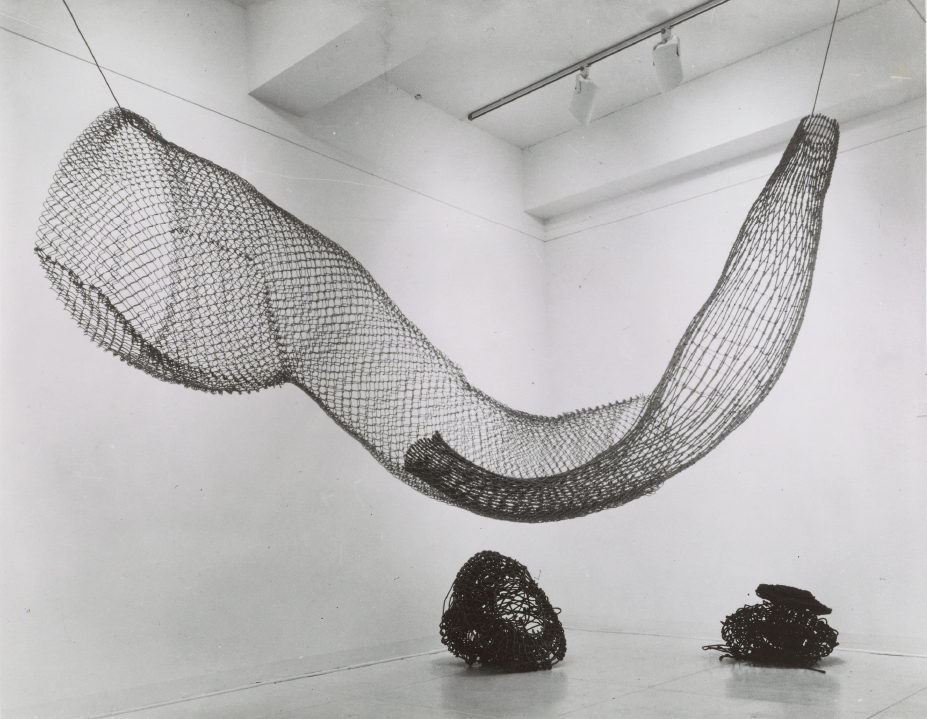
If you came to this show accidentally, or as a layperson, it could confirm any prejudices you might have about avant-garde sculpture. Pretentious, ugly and resorting to kink. Those pendulous string bags, that enormous turd – gimme a break.
Except that would be a mistake. Because the work here is the real thing: the 1960s originals that spawned a million imitations and parodies. The exhibition is perhaps a little cool about selling itself, so allow me. This is a snapshot of the work of three artists around the time they all took part in a 1966 New York show called Eccentric Abstraction. Two of the artists, Louise Bourgeois and Eva Hesse, were nascent superstars.
Bourgeois, then in her fifties, was working with ‘soft, yielding’ materials such as plaster and wax for the first time. But she could already conjure Brothers Grimm-style psychodrama from any innocent old coil of splat. Her aesthetic was well under way: a phallus cast from pigmented urethane rubber, and hanging from a metal wire, is titled ‘Fillette’ (1968-9) or ‘little girl’. ‘Lair’ (1962), a charismatic latex cowpat, is structured so you can peep voyeuristically into its glutinous interior.
A small auxiliary show of her drawings downstairs reveals work and life colliding – as they tend to. ‘I have discovered this morning… a wax for children, a kindergarten crayon, I think it’s called a Crayola… which is a great help because I have hundreds of them floating around the house… whereas my elegant litho crayons or negative crayons I am unable to keep. People walk away with them, at school and at home,’ she recorded in an audio diary in 1975, a quote displayed alongside repetitive, self-soothing sketches.
The self-contained totem-like sculptures from the 1960s remained key pieces in her arsenal – Robert Mapplethorpe photographed her with ‘Fillette’ under one arm in 1982 – although her vision expanded into whole rooms, towering spiders and mises-en-scène. By the time she died in 2011 aged 98, even the wider world had caught on.
The long run at life was not granted to Eva Hesse, the other star here. She died of a brain tumour aged 34, precociously visionary, wittily wild. A wounding loss. Selma Blair played her in a docudrama. Born in Hamburg in 1936, she came to England on the Kindertransport aged two and thence to New York. She studied under Josef Albers at Yale and had a decade on the scene with close muckers Donald Judd, Yayoi Kusama, and Sol LeWitt.
These are the real thing: the 1960s originals that spawned a million imitations and parodies
Her work when it is exhibited is sometimes all the more poignant because of the way it has decayed, being made of deliberately transient material such as latex that has dried and cracked. As she once observed: ‘Life doesn’t last; art doesn’t last.’ But the work selected here is durable stuff, playfully assertive, and presented more or less as it would have been before there was any aura of canonisation about her, when she was just another young turk. ‘Addendum’ from 1967 is a teasing yet formal line-up of papier-mâché mounds, extruding over-long cords. ‘Endless repetition can be considered erotic,’ Hesse wrote that year. Mysterious and compelling.
Bourgeois could conjure Brothers Grimm-style psychodrama from any innocent old coil of splat
The third artist, Alice Adams, was a trained weaver who, in the radical spirit of the 1960s, put down her loom and started manipulating tarred rope, chain-link fencing and rusted steel cable. It was a response to the intense redevelopment of Manhattan in the 1950s and 1960s, which at the time made her feel ‘physically injured’. Now 94, she gives cheerful testimony about the strange looks she got in builders’ yards and the steel cable she gleaned when the YMCA on 92nd Street was broken up. She was subsequently drawn towards land art and, like Anthony Caro, advised on infrastructure projects. Her 2023 partial remake of ‘Big Aluminium 1’ (1965, see below), hangs here like a vast sex-ed diagram made out of chicken wire.

These works summon the senses, their materiality and sense of process analogous with corporeality and bodily change. Whether they are erotic is, of course, debatable. Yes, playfulness and wit is here, but pleasure? For those with an interest in post-minimalism, this is a resounding yes.








Comments